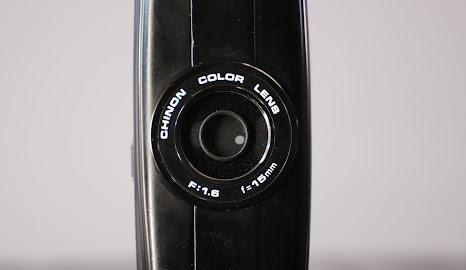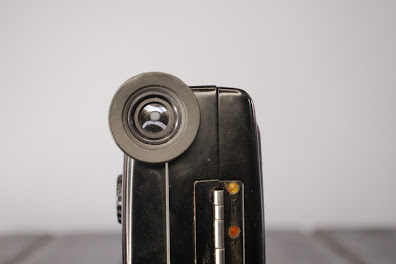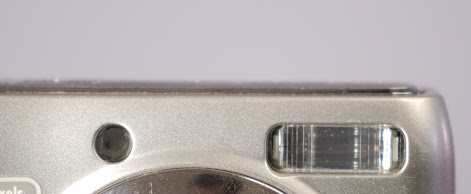Go from film camera to film camcorder, in this post I
will be looking at the 8mm and Super 8mm camcorder, the Chinon Pocket-8. I
really like this camcorder just because I really like the way 8mm film looks
and the potential of the story telling and experimenting that can be done with
it.
First
a look at the Chinon company history. Started in 1948 Japan, by Hiroshi Chino
focusing on manufacturing Lenses, cameras, disk drives, printers and movie
cameras (film camcorders). Chinon was also a partnered with Kodak and went by
the name Chinon Industry Inc. and by 1997, Kodak became its majority
shareholder and later merged Chinon into the Kodak company, but the Chinon
Corporation was restarted “by the founder's family as the formal successor.”
(ChinonShop 2012)
Interestingly
enough Chinon started making lenses for many top Japanese camera companies,
most notably Canon. But “Although widely respected for their innovations, they
did not begin marketing under their own name until about 1972…” (OzCamera). The
company also went through different name changes, first Sanshin Seisakusho from
1948-1962, then Sanshin Optics Industrial Co. Ltd until 1973 and finally Chinon
Iindustries Inc. (Taranto Metropolitan University). It has been restarted as
mentioned above, but the Chinon company is still owned by Kodak (specifically
Kodak Japan Limited) since 2004 (Science Museum Group).
Chinon
isn’t what most camera collectors think of, but as Eckman (2017) points out: “Their
cameras were quite well built, but they weren’t exactly a company known for
innovation. In fact, many Chinon made cameras were rebadged and sold
under the brand names of other manufacturers such as Argus, GAF/AGFA, Revue,
Sears, Alpa, and Albinar. As a result, there are far more Chinon made
cameras out there than most people probably realize.” Meaning that most
collectors might already own a few Chinon cameras without even realising it!
According
to Eckman (2017), Chinon started branding their products in 1958 when they
released their first 8mm motion picture lens. Which is interesting because when
they started releasing their own cameras (both still and motion) under their
company name in 1973 with their new name, “Chinon was heavily involved in 8mm
movie cameras. In 1976, they produced over 800,000 sound and silent movie
cameras (38% of the world's production). In 1980, they claimed to be the world’s
largest producer of Super 8…” (OzCamera).
But
with the introduction of video, Chinon was losing money and in 1983 teamed up
with NEC to create the 8mm video, which caught the eye of Kodak. This lead to a
partnership between Kodak and Chinon in 1985 “in which Chinon would produce
35mm cameras bearing the Kodak label. At the time, Kodak owned about 9.5% of
Chinon stock. In 1997, after three successive years of losses, Chinon was
acquired by Kodak and continued to make Kodak products including digital
cameras.” (OzCamera)
Now
for the item at hand, the Pocket-8. This film camera was released in 1978
(FilmKorn) and is one of the smallest super-8 cameras made and “fits into a
coat pocket” (Classic Cameras 2024).
The camera comes with a built in and fixed Chinon Color Lens, with a focal length of 1.6 at 15mm. It also has a fixed aperture with an f/stop of 8 (Kamera Store 2024).
But if the user wanted to upgrade this, they could buy the zoom lenses that was separately sold. There were three different lenses available: “Wide Angle lens, Telephoto lens (1.7 8-32 mm), Cinemascope lens (Anamorphic Widescreen lens)…” (Filmkorn).

Chinon Pocket-8 zoom lenses. Image Source: http://super8wiki.com/images/b/bd/Chinon_Pocket_8_anamorphic.jpg
.png) |
| Chinon Reflex Pocket-8 8-32mm f/1.7 Zoom Lens. Image Source: https://i.etsystatic.com/9425325/r/il/c99a0b/4207472648/il_1140xN.4207472648_ibjp.jpg |
On top…
Is
the aperture setting to help with the type of lighting used. It has two
settings: Indoor (artificial) lighting and outdoor (daylight) lighting. These
setting set the film speed to 100 (daylight) and 160 (artificial) ASA, which
has a notching of 1-pin (Filmkorn).
Behind that is the Shutter button. This is used by holding the shutter in that causes the spinning mechanism to “crank” the film cartage and take footage at a speed of “18 / 36 frames per second” (Classic Cameras 2024) inside the film compartment. Behind that is the focus wheel, which is used to?... That’s right adjust the focus!
Is
the view/ridge finder, which is a “single-lens reflex with adjustable eyepiece”
(Filmkorn) or SLR for short (see Olympus
OM30 Film Camera posts for more information on this).
Underneath
the viewfinder right at the bottom is the DC 6V socket to possibly power the
35mm slide copier, that much like the zoom lenses, were a separate attachment
that the user could buy and was used to copy the images from the Super 8 film
onto 35mm slides. This is possibly also used for a remote system (Filmkorn).
 |
| 35mm slide copier. Image Source: https://www.filmkorn.org/super8data/database/cameras_list/cameras_image/chinon_pocket8.jpg |
Now
for the left side…
Nearest
to the lens is the exposure setting. This can be switched to auto, which
adjusts the exposure to the environment and indicates this with a red line that
appears on the readings in the window next to the knob. But this can be
switched to manual, where the red line is moved by the user and stays in place.
Next to that is the backlight control button, which is used to compensate for lack of lighting and harsh lighting by manually opening up the aperture to a few more stops (The Whole Picture 2023). And next to that is the 36 fps button. This increases the shutter speed from 18 seconds (when the shutter is used alone) to 36 seconds (when the 36 button and shutter are pressed simultaneously together.
Underneath
all of these settings is the Film remaining indicator window, which gives an
indication of how much film is left in the cartage in terms of the Super 8
film’s length in both feet and meters.
Underneath…
Is
the tripod, 35mm and pistol hand grip (also an optional separate attachment)
sockets.
 |
| Chinon Pistol camera grip. Image Source: https://cameracrate.com/wp-content/uploads/2023/11/chinon-38-pacific-super-8-camera-300x300.jpg |
On
the right side…
Is
the slide button to open the film compartment.
The
film compartment has a window to indicate what type of Super 8 film is inserted
and to indicate the ASA (K25 (daylight) and K40 (artificial) film) to make sure
that the right aperture setting is set.
Inside the compartment is the DC micromotor (film drive motor) that spins or cranks the film in the cartilage.
The
compartment is also where the batteries are inserted. This camera operates with
two AA batteries.
This
camera also came with a leather back and carrying case.
I
did go over the history of the 8mm film in my The
It’s Cragstan 8mm Portable Projector post, as well as some history of the
Super 8 film, but I will go more in-depth on that here.
This
camera takes Super 8 film, specifically K40 and K25 as mentioned above. But it
should be noted that there are two different types of Super 8 film, silent and
sound (Nostalgic Media 2024). Silent, which is the type the Chinon Pocket-8
uses, just records footage and sound, which uses a magnetic strip to record
sound, captures both footage and sound.
.png) |
| Difference between Super 8 Silent film and Sound film. Image Source: https://cdn.shopify.com/s/files/1/0429/4769/files/film-sound-types_480x480.jpg?v=1627670957 |
Super
8 film was introduced in 1965 by Kodak and according to Kodak’s (2024) website:
“Kodak
introduced the Super 8mm format, which included film, cameras and projectors.
Cheaper and more convenient than previous formats, this is what really brought
movie-making to the masses. Cartridge loading eliminated threading the film and
was virtually foolproof. Made out of plastic, it meant no more jamming, which
was a common issue with the 16mm Cine-Kodak magazine. And the entire 50-foot
cartridge could be shot without interruption. The cartridge itself provided
information to the camera about the speed (ASA) of the film as well as filter
information for black-and-white products. Precision notches were set at
specific points on the edge of the cartridge, activating mechanical or
electronic switches in most Super 8 Cameras, most of which were built with
battery-powered motors, eliminating the need to wind a spring-driven
transport.”
Basically,
like the 110 film and 126 film, the Super 8 was to make 8mm film much easier to
use.
There
are also many differences between the 8mm and Super 8. This being that the
Super 8 has smaller sprocket holes and are in the middle of the frame. Second
is that Super 8 comes in a cartage, like the 110 film (see Minolta
110 Zoom SLR film camera and KODAK Pocket
Instamatic 10 Camera posts) and the 126 film (see Kodak
Instamatic 104 Camera post) and thus doesn’t have to be winded out into the
camera or rewinded when finished. Instead it can just be directly inserted and
taken out, without the risk of accidental exposure. In fact, the only thing
that the 8mm and Super 8 have in common is that they are the same size. (Roemer)
.png) |
| Differences between Super 8 and 8mm film. Image Source: https://cdn.shopify.com/s/files/1/1933/0091/files/ENTERTAINMENT-super8-8mm-infographic_1024x1024.jpg?v=1501016266 |
It
was basically part of Kodak’s mission to make capturing on film easy as
possible and well the Super 8 can be thought of as the “everyday man’s type of
film…” (Roemer).
And
to drive it home here is an excerpt from Nostalgia Media’s (2024) article Ultimate
Guide to Film Types: 8mm, Super 8, and 16mm Film:
“Super
8 film is probably the most recognized and widely used film stock by
amateur filmmakers. Introduced in 1965, Super 8 film was quickly adopted thanks
to higher image quality and having an easier cartridge loading system compared
to standard 8mm. Super 8 film was also specifically designed to accommodate a
sound track. Sound film can be identified by a thin rust-colored strip
along the film between the edge of the film and the image area. Super 8 film is
still being sold and manufactured today, with Kodak announcing in 2017 that
they would once again make Ektachrome available in the Super 8 format.”
Now
for an explanation on how it captures footage. First is that the light goes
through the lens and exposes each individual frame. The shutter opens to let
the light in and as the frame is exposed, the shutter closes and reopens once
the next frame gets into position (Imperfect Cine Club 2011). It does this at a
very fast pace and manages (for the Pocket-8 at least) to expose 18/36 frames
per second.
This
light then reacts to the film, which is known as cine film and is different
from photographic/C41 film. One difference is rimjet. Rimejet is added to avoid
leakage and damage from the heat that generates due to the fact that cine film
takes multiple shots in a rapid succession. Rimjet is basically a “thick black
layer on the reflective side of the film. It's also the reason most labs can't
process cine film. It generally doesn't remove easily and has the potential to
contaminate the chemistry in automatic film processing machines.” (Wellington
Film Lab 2024)
But
other than the rimjet, it appears to work the same as C41 film (Masterclass
2021), please see my Kodak
200 Color Plus Film to learn more about that.
But
the developing of the Super 8 and cine film is different and is known as a
process called ECN-2 which uses “CD3 developer which is an older compound. Cine
film can also be cross processed in C41 chemistry (CD4 developer) once the
remjet layer is removed. ECN-2 process results in more true to life colour
replication and better resolution of the film grain. It also produces flatter
negatives with less contrast (designed for cinemas) whereas cross processing in
C41 may see some colour shifts, denser negatives and greater contrast.”
(Wellington Film Lab 2024)
For
a step-by-step process on this development, please see Manning’s (2021) article
ECN-2 Processing: Everything You Need to Know for more information:
https://studioc41.net/2021/07/18/ecn-2-processing-everything-you-need-to-know/
But
remember to choose the right film ASA before shooting to make sure it is
compatible with the lighting used!
And
there it is. I really like this camera because of the nostalgic look of the
footage. Which like my constant mentioning in my Panasonic/National
NV-M5 Camcorder and Olympus
OM30 Film Camera posts, that if you want to get that old look, then use the
actual technology instead of a filter! It does make for more work, but it is
worth it in the end result.
Another
thing I like from this camera is its size. Like most cameras I mention that are
small and easy to use and begin with if you are a digital camera user, I
recommend starting with this if you want to shoot a movie on film (just
remember that there are very little room for error, especially since one Super
8 cartage can only shoot around 2:30 and 3 minutes!). It is also small enough
and compact to pack in a back or even your pocket (hey maybe that is where the
name came from!).
Thank
you for making it to the end and as always I hope you enjoyed reading this as
much as I did researching it.
If you want to help this site out, please consider joining my Patreon: patreon.com/OnlineCurator
Please see the Please help this site post on this blog, for more information.
List of sources
ChinonShop. 2012. About
CHINON. https://www.chinonshop.com/pages/about-chinon
Classic Cameras.
2024. FILM TESTED Chinon Pocket-8 Super-8 movie camera. https://classiccameras.com.au/products/film-tested-chinon-pocket-8-super-8-movie-camera?srsltid=AfmBOoqxEBp-6W1g7qHZANMM_or4AzAAq2mD2UhhM6g0d4C6kngiyPCf
Eckman, M. 2017. Chinon
CE-4 (1980). https://mikeeckman.com/2017/10/chinon-ce-4-1980/
Filmkorn. Chinon
Pocket 8. https://www.filmkorn.org/super8data/database/cameras_list/cameras_chinon/chinon_pocket8.htm
Imperfect Cine Club.
2011. Introduction to Super-8mm Film. https://imperfectcinema.com/wp-content/uploads/2011/02/Super8.pdf
Kamera Store. 2024. Chinon
Pocket 8 – Camera. https://kamerastore.com/products/chinon-pocket-8?srsltid=AfmBOoq3agLBdPP0p0vQ-J8ihIsEBlJCHPP0isnhvTZyolbWDPB0T9lq
Kodak. 2024. The
History of Super 8. https://www.kodak.com/en/motion/page/super-8-history/
Masterclass. 2021. Celluloid
Film History: How Celluloid Film Works. https://www.masterclass.com/articles/celluloid-film-guide
Nostalgia Media.
2024. Ultimate Guide to Film Types: 8mm, Super 8, and 16mm Film. https://nostalgicmedia.com/blogs/media-conversion/guide-to-film-types-8mm-super-8-and-16mm-film
OzCamera. Chinon
Cameras. https://www.ozcamera.com/chinon.html
Roemer, C. The
Difference Between 8mm and Super 8mm Film. https://legacybox.com/blogs/analog/8mm-vs-super8-film
Science Museum Group.
Chinon Industries Incorporated 1954. https://collection.sciencemuseumgroup.org.uk/people/cp122508/chinon-industries-incorporated
The Whole Picture. 2023.
SUPER 8 | Everything You Need To Know Before Filming. https://www.youtube.com/watch?v=rpiTkQb9iXE
Toronto Metropolitan
University. Chinon Industries Inc. https://archives.library.torontomu.ca/index.php/chinon-industries-inc
Wellington Film Lab.
2024. Cine Film Shooting Guide. https://wflnz.com/pages/cine-film-guide#:~:text=Cine%20film%20is%20designed%20for,reflective%20side%20of%20the%20film.









































.png)
.png)
.png)

.png)
.png)

.png)
.png)
.png)




.png)



